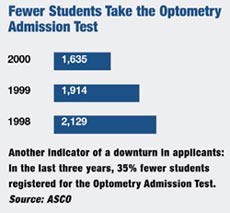Applications to optometry schools have dropped 25% in the past two years, the Association of Schools and Colleges of Optometry (ASCO) reports.
The decline in applications indicates a decline in the number of applicants, ASCO surmises.

“A small applicant pool eventually affects each institution’s ability to be selective in the admissions process,” says ASCO President John Schoessler, O.D., Ph.D.
“If the caliber of individuals graduating from optometry schools is threatened, then so is the profile of our future colleagues and, ultimately, patient care,” he says.
The decline in applicants among optometry schools ranges from 1% to 32%, depending on the school.
That compares with a general decline among schools for health care professions, says Mark Colip, O.D., dean of student affairs at Illinois College of Optometry in Chicago.
Applications to medical schools have dropped 21% from 1995 to 2000. Podiatry school applications are half of what they were five years ago, Dr. Colip says.
“If [applications] continues to drop the way they are currently, certainly in the next two or three years we’re going to be in a situation where there’s going to have to be some very tough decisions being made,” says Ed Johnston, O.D., vice president for student affairs at State University of New York College of Optometry.
What’s causing the slump? ASCO director of career promotion and student affairs Joan Anson chalks it up to several reasons:
- The past economic boom has drawn undergraduate students to higher-paying, high-tech jobs (which also don’t require a heavy debt load to finance education).
- Potential applicants were turned off by news stories about doctors harried by managed care.
- The rise of LASIK could have misled students to conclude there will be less need for optometrists.
To maintain a higher caliber of applicant, ASCO has set a goal to have three applicants for each accepted student in any optometry class. But that figure is now less than two applications per available place, Dr. Colip says.
To hike up those applications, ASCO is launching a grassroots effort to incite optometrists to promote the profession to high school and college students.
The idea is not to increase class size, Dr. Johnston emphasizes. Indeed, ICO anticipated this decline and reduced its class size from 174 a few years ago to 150 for next year’s class, Dr. Colip says. Optometrists themselves are the primary influence on students toward entering the profession, Ms. Anson says.
To increase the applicant pool, ASCO will encourage optometrists to chat with students to consider a career in optometry, and mentor them when appropriate. A concurrent effort is to raise diversity among applicants.
ASCO provides literature and a Web site (www.opted.org/info_ main.cfm) that you can show to young people (or their parents) if they’re interested.
Despite the challenges of managed care and a flagging economy, “the fact is, optometry is a great way to make a living,” Dr. Colip says. “And it’s still a great profession for young people.”

